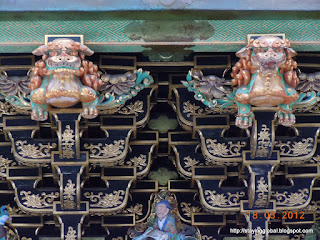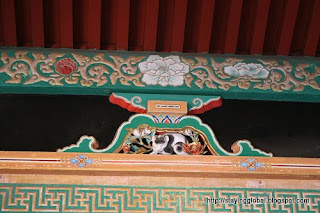Toshogu,
the most lavishly decorated shrine is also the most well known of all shrines
and temples in Nikko. It houses the mausoleum of Tokugawa Ieyasu, the founder
of the Tokugawa shogunate. This powerful ruler founded a dynasty that ruled
Japan for over 250 years with its capital in Edo, current day Tokyo. Ieyasu’s
posthumous Buddhist name was Tosho-Daigongen, after which Toshogu is named.
The Drum Tower and Bell Tower are ornately carved as seen in the picture below.
Situated behind the Drum Tower is a building called Honji-do.
The ceiling is painted with the image of a crying dragon. When hands are clapped beneath it, the echo resounds, perhaps implying the dragon's crying.
The exteriors of all buildings are allowed to be photographed. Photography is prohibited inside the halls.
It
is said that an ailing Ieyasu, expressed as his final wish to his successors,
the building of a small shrine in Nikko enshrining him as the guardian God of
Peace in the country. Ieyasu
was buried immediately after his death in 1616 but the Toshogu mausoleum was
built in 1634 on the orders of his grandson Iemitsu who was the third Tokugawa
shogun. It took about 2 years for 15000 artisans from all over Japan to build
this magnificient mausoleum. The monument has been lavishly carved, gilted,
painted, lacquered to such an extent that it is often said that at Toshogu,
anything that can be decorated has been decorated.
The
mausoleum was designated as a shrine in the Meiji period, but interestingly it
retains many of its Buddhist elements like a pagoda, a Buddhist temple style
Niomon gate etc.
At
the entrance to the shrine is a granite stone torii. To the left is a 5
storeyed Pagoda, which was donated by a feudal lord in 1650.
It was destroyed in a fire and rebuilt in 1818. Each storey represents the 5 elements- Earth, Water, Fire and Wind.
It was destroyed in a fire and rebuilt in 1818. Each storey represents the 5 elements- Earth, Water, Fire and Wind.
The
Niomon gate stands a few metres ahead and is guarded by two Nio guardians. A
walking trail leads past an array of stone lanterns on either side.
On the right hand side stand the traditionally designed sacred store houses.
These storehouses also carry some interesting carvings and decorations.
On the left is an unpainted wooden stable where a horse gifted by the Govt of New Zealand is stabled for few hours everyday.
The building is decorated by a carving of the three wise monkeys “Sanzaru”- Kikazaru, Mizaru and Iwazaru, who respectively “hear no evil, see no evil and speak no evil”.
These three monkeys have become sort of a symbol for Nikko city and Toshogu.
More monkey carvings apparently depicting stages from life cycle of monkeys adorn the stable building.
Few metres ahead is a granite structure housing the sacred fountain used for ritual purification.
On the right hand side stand the traditionally designed sacred store houses.
These storehouses also carry some interesting carvings and decorations.
On the left is an unpainted wooden stable where a horse gifted by the Govt of New Zealand is stabled for few hours everyday.
The building is decorated by a carving of the three wise monkeys “Sanzaru”- Kikazaru, Mizaru and Iwazaru, who respectively “hear no evil, see no evil and speak no evil”.
These three monkeys have become sort of a symbol for Nikko city and Toshogu.
More monkey carvings apparently depicting stages from life cycle of monkeys adorn the stable building.
Few metres ahead is a granite structure housing the sacred fountain used for ritual purification.
Next
to it is another stone Torii.
To its left is a wooden building, Rinzo which houses a sutra library of Buddhist scriptures.
To its left is a wooden building, Rinzo which houses a sutra library of Buddhist scriptures.
A
flight of stairs leads to the identical Drum tower(on the left) and Bell tower(on
the right) which signify Positive and Negative energy respectively.
The Drum Tower and Bell Tower are ornately carved as seen in the picture below.
Situated behind the Drum Tower is a building called Honji-do.
The ceiling is painted with the image of a crying dragon. When hands are clapped beneath it, the echo resounds, perhaps implying the dragon's crying.
The
Yomeimon Gate is the lavishly decorated gate which marks entrance to the shrine’s
inner complex.
Carvings of beasts, flowers, birds, human beings adorn the Yomeimon’s 12 columns.
The niches in the gate are occupied by Imperial ministers, guarding the shrine.
Carvings of beasts, flowers, birds, human beings adorn the Yomeimon’s 12 columns.
The niches in the gate are occupied by Imperial ministers, guarding the shrine.
Wooden
wall panels on both sides of Yomeimon gate are decorated with carvings.
The right side is adorned with peacock carvings, while the left is adorned with other birds.
Further ahead is another gate the Karamon gate, the smallest of all gates in Toshogu.
The right side is adorned with peacock carvings, while the left is adorned with other birds.
Further ahead is another gate the Karamon gate, the smallest of all gates in Toshogu.
Over
an entrance in the east corridor, is the carving of a tiny sleeping cat, Nemuri
Neko.
It is said that when seen from one angle, the cat appears to be awake, while from another it looks to be asleep. To see the Nemuri Neko, an additional ticket priced at yen 520 needs to be purchased.
It is said that when seen from one angle, the cat appears to be awake, while from another it looks to be asleep. To see the Nemuri Neko, an additional ticket priced at yen 520 needs to be purchased.
The
special ticket also entitles visitors to visit the burial place of Ieyasu,
which in reality is a simple tomb with a treasure tower containing his ashes. A
fleet of 200 stone steps leads to the burial site.
True to its reputation of being the most ornately decorated shrine in Japan, each and every roof, pillar, door is decorated. The smallest of the buildings are also lacquered, gilted and carved. It would not be wrong to say that there is practically nothing simplistic about Toshogu.
True to its reputation of being the most ornately decorated shrine in Japan, each and every roof, pillar, door is decorated. The smallest of the buildings are also lacquered, gilted and carved. It would not be wrong to say that there is practically nothing simplistic about Toshogu.
The exteriors of all buildings are allowed to be photographed. Photography is prohibited inside the halls.
Opening
Hours: 8:00-17:00 hrs ( Last admission 30 mins before closing time)
Closes at 16:00 hrs
between November-March
Closing
Days: Open 365 days
Admission fees : 1300 yen for
all parts of Toshogu.
1300 yen Combination
ticket which includes entrance to Sanbutsu-do,
Treasure House,
Shoyoen garden, Toshogu Shrine, Taiyuin Byo and
Futarasan
Shrine. However combination ticket does
not include admission
to the Nemuri Neko
carving and Ieyasu’s tomb. Additional ticket priced at
Yen 520 can be
purchased at the entrance to the Nemuri Neko carving.








































No comments:
Post a Comment